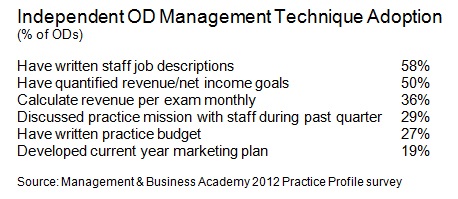SPONSORED BY VISION SOURCE
By Thomas F. Steiner
Director of Market Research,
Review of Optometric Business
Vision Source is the leading alliance of independent ODs, with 2,700+ member practices and 5,500+ member doctors in the US and Canada. The organization is actively engaged in advancing the competitive position of independent ODs. Earlier this year, Vision Source commissioned the editors of Review of Optometric Business to develop an objective analysis of the current state of independent optometry and to identify strategic priorities for bolstering competitiveness. This article distils one section of the full report, identifying the major competitive weaknesses of independent ODs.
>>>Click HERE for a COMPLIMENTARY download of the full report “Challenges and Opportunities in the Future of Independent Optometry<<<
Although independent ODs enjoy a strong competitive position, many exhibit weaknesses which make them vulnerable to patient defection to commercial providers and which produce sub-optimal financial returns.
1. Insufficient management discipline and sophistication
Independent ODs spend years learning to be clinical technicians and most are highly proficient in the medical aspects of practice. But few receive much education about running a small business, which is just as important to success.
Many ODs do not apply even the most rudimentary business management techniques to run their practices. For example, only about one-in-four practices has a written annual budget and one-in-five have a current marketing plan. 2. Ineffective eyewear merchandising
2. Ineffective eyewear merchandising
Vision Watch reports that in 2012 independent ECPs conducted 68 percent of the eye exams performed in the US, but sold just 43.7 percent of frame pairs. That suggests that one-in-three eyeglass patients of independent ECPs takes their prescription to another provider to be filled. Said another way, the average frames capture rate is just 64 percent of the frame purchases of patients of independent ECPs.
Among the major reasons patients of independent ODs take their eyewear prescription elsewhere is inadequate eyewear merchandising. When frames are haphazardly displayed or when selection is limited, patients can conclude that selling eyewear is not a specialty or priority of the practice and decide to find their ideal pair of glasses somewhere else.
Inadequate attention to eyewear merchandising plays right into the hands of the optical chains. These retailers make eyewear merchandising their top priority and most important competitive edge, and devote much of their office square footage to eyewear display. They know that the principal reason customers come to their stores is to enhance their personal appearance with attractive eyewear. That’s the same reason most patients go to independent OD offices, as well, but not all practices choose to recognize that.
3. Less buying power/higher retail prices
Large optical chains are able to negotiate low prices from eyewear and contact lens manufacturers, which can be passed on to consumers in lower retail prices. Lower price is a leading reason consumers select chains for eyecare.
4. Less convenient office hours
A 2010 consumer survey sponsored by EyeMed revealed that 40 percent of consumers who are in the market for vision correction services prefer weekend or evening hours over nine-to-five workday hours. Twenty-five percent of eyecare consumers said they preferred Saturday hours, 12 percent evening hours and 4 percent Sunday hours.
Independent OD offices are open for business an average of 44 hours weekly. About half are open Saturday mornings and 44 percent are open in the early evening on one or more days a week. By contrast, virtually all optical chain locations are open Saturdays and many on Sundays. Many chains are open during the week until 9 pm or 10 pm every night. The restricted office hours of some independent OD offices is a competitive weakness that results in some patients seeking chain optical locations with more convenient hours.
Strategy Implications
To eliminate or reduce the primary competitive weaknesses of independent ODs the following strategies should be adopted:
• Set aside time for management
Business analysis, planning and oversight are among the critically important things competing for an OD’s attention. But these activities are not brush fires that demand immediate attention. Lacking urgency, these critical activities are often postponed or given token attention. To assure that time is spent on managing, ODs must block off hours on the appointment calendar each week, when no patients will be seen. Some consultants recommend that 20 percent of an owner’s working hours be spent on management.
• Personally direct dispensary operations
It’s a mistake to totally delegate management of the leading profit center of a business, which is the optical dispensary in most independent OD practices. Owners who devote personal attention to the eyewear product mix, frames inventory management, eyewear retail pricing and dispensary displays can neutralize the competitive advantage that retail optical chains now have as eyewear merchants.
• Offer convenient hours
Every independent practice should offer some hours on Saturday and evenings to accommodate patients whose schedules make it inconvenient to visit the office during normal weekday business hours.
The next article in the series will discuss the largest revenue growth opportunities independent ODs have.
Thomas F. Steiner, Director of Market Research for ROB, has spent more than 25 years helping eyecare practices succeed, including pioneering the introduction of color contact lenses into optometry. To contact him: tom.steiner@cibavision.com

























